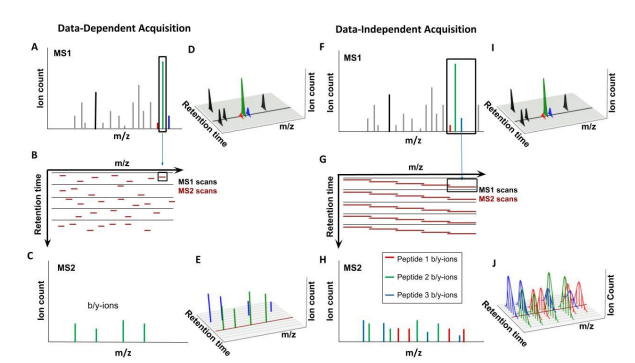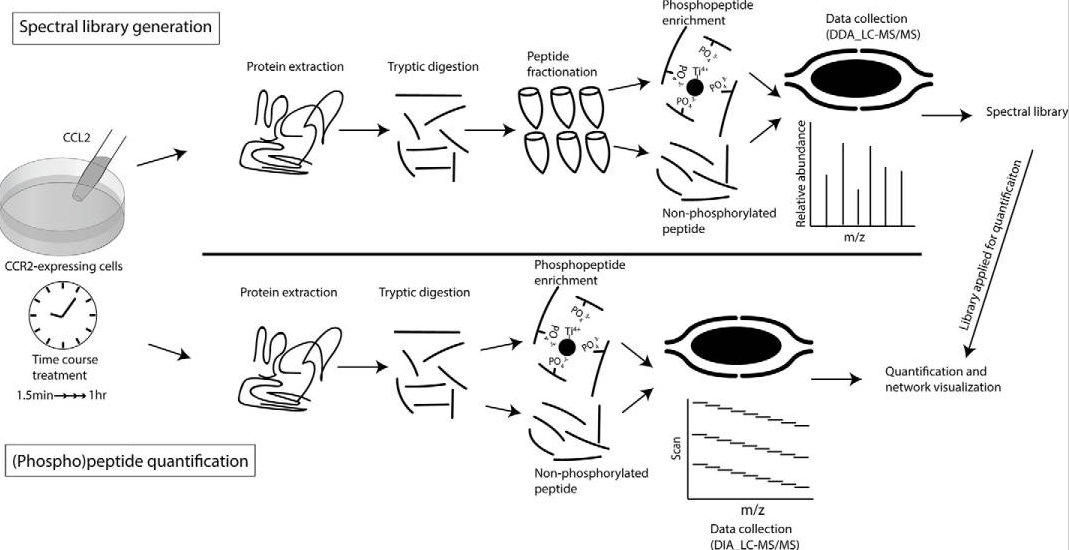DIA Mass Spec Analysis Service
Data-Independent Acquisition (DIA) Mass Spectrometry Analysis is a comprehensive, unbiased mass spectrometry data acquisition method. It fundamentally differs from traditional Data-Dependent Acquisition (DDA) mass spectrometry analysis. In DDA, only the most intense ions in a sample (typically the most abundant peptide ions) undergo fragmentation and tandem mass spectrometry (MS/MS) analysis. In contrast, DIA mass spectrometry technology fragments and performs MS/MS analysis on all ions within the entire mass spectrometry scan range without bias. Specifically, DIA mass spec analysis service divides the full mass spectrometry scan range into multiple small windows and sequentially selects, fragments, and detects all ions within each window. This approach enables DIA to comprehensively capture all fragment ion information in a sample, significantly improving data utilization and analytical coverage.
Leveraging advanced instrumentation such as Orbitrap Astral, Orbitrap Exploris 480, and TIMS TOF Pro2, MtoZ Biolabs provides DIA mass spec analysis service as a core offering, establishing a comprehensive service system in both standard proteomics and post-translational modification (PTM) analysis.

Nishant, P. et al. Chembiochem, 2019.
Figure 1. Comparison of DDA and DIA.
Technical Features
1. High Sensitivity and Resolution
DIA mass spectrometry analysis is typically performed using high-resolution mass spectrometers, enabling the detection of low-abundance peptides with precise quantification and identification. Additionally, high-resolution instruments provide clear fragment ion peaks, facilitating accurate peptide and protein identification.
2. Comprehensive Coverage
Unlike traditional Data-Dependent Acquisition (DDA) mass spectrometry, which selects only the most intense peptide ions for fragmentation, DIA mass spectrometry fragments and detects all peptide ions across the entire mass range without bias. Therefore, DIA technology can capture fragmented information of all peptides in the sample, avoiding information omissions due to selection bias.
3. High Reproducibility and Reliability
Since DIA mass spec analysis service performs indiscriminate fragmentation and detection of peptides within the entire mass range, its analysis results have high repeatability and reliability. This feature makes DIA technology particularly advantageous for repeated experimental validation and large-scale proteomics studies.
4. High Throughput and Efficiency
DIA mass spec analysis can simultaneously quantify and identify a vast number of proteins across multiple samples, significantly improving analytical efficiency. Furthermore, because DIA does not require pre-selection of peptides for fragmentation, it reduces experimental time and costs, enhancing both throughput and efficiency.
Service Advantages
MtoZ Biolabs has extensive experience in DIA mass spec analysis service and leverages the unique technical features of DIA technology to offer three core advantages:
1. Targeted Experimental and Data Acquisition Strategies
We also have different requirements for experimental treatment according to different samples. For example, plasma, cells, or tissues, we design specialized experimental protocols for a specific type of analyte, and according to the different test items to select the appropriate equipment for analysis, to ensure that customers get satisfactory results.
2. Advanced Analytical Platform
Based on DIA mass spectrometry analysis, we have built a complete analysis platform around Diann, Fragpipe, Spectronaut and other analysis software, which can achieve accurate, fast and efficient data analysis.
3. Expert Service Team
For DIA mass spec analysis, we are equipped with multiple technicians who have been engaged in many years and have rich experience in DIA analysis and reporting.
Sample Submission Suggestions
1. Sample Types
We accommodate a wide range of sample types, including gel strips, protein solutions, solid powders, cells, animal and plant tissues, and metabolites.
2. Sample Amount
The required sample amount may vary depending on the sample type and project. For detailed requirements, please consult us.
Note: If you have any specific requirements or need assistance with sample preparation, please contact us.
Applications
1. Protein Identification and Quantification
DIA mass spec analysis service enables the qualitative and quantitative detection of proteins in samples, providing a powerful tool for biological research. With DIA mass spec analysis, researchers can gain deeper insights into protein expression levels, post-translational modifications, and protein-protein interactions.
2. Revealing Protein Structure and Function
When combined with other techniques, such as hydrogen/deuterium exchange mass spectrometry (HDX-MS), DIA mass spectrometry can further reveal protein structures and functions. For example, DIA acquisition methods allow simultaneous collection of deuterium-labeled data in both MS1 and MS2 fields, aiding in the study of protein folding mechanisms and the discovery of ligand-binding sites.
3. Drug Target Screening and Validation
DIA mass spec analysis service can be used for drug target screening and validation. By comparing the changes in the proteome before and after drug treatment, researchers can identify potential drug targets.
4. Drug Metabolism and Pharmacodynamics Research
DIA mass spec analysis can study drug metabolism and pharmacodynamics. By monitoring the metabolic process of drugs in the body and changes in pharmacodynamic indicators, it can help evaluate the efficacy and safety of drugs.
5. Environmental Science and Food Safety Research
In environmental science, DIA mass spec analysis service can be used to detect and analyze pollutants and biomarkers in environmental samples. In the field of food safety, DIA mass spec analysis enables the rapid detection of food additives, pesticide residues, and other harmful substances, ensuring food quality and consumer safety.
Case Study
This study utilized phosphoproteomics to provide an unbiased characterization of the signaling network induced by CCR2 activation via CCL2. Using DIA mass spec analysis, the researchers conducted quantitative analysis of the phosphoproteome in FlpIn-HEK293T cells that stably express CCR2 at six time points following CCL2 activation. Differential expression analysis identified 699 significantly regulated phosphorylation sites on 441 proteins. As expected, many of these proteins were involved in classical signal transduction pathways and the regulation of actin cytoskeleton dynamics, including a large number of guanine nucleotide exchange factors (GEFs) and GTPase-activating proteins (GAPs). Additionally, the researchers identified regulated phosphorylation sites on proteins that function within the nucleus, including several components of the nuclear pore complex. This study provides valuable insights into CCR2 signaling mechanisms and identifies potential targets for CCR2 functional regulation.

Huang, C. et al. The Journal of Biological Chemistry, 2020.
Figure 2. Schematic Representation of DIA-based Phosphoproteomics Analysis.
Deliverables
1. Comprehensive Experimental Details
2. Materials, Instruments, and Methods
3. Total Ion Chromatogram & Quality Control Assessment
4. Data Analysis, Preprocessing, and Estimation
5. Bioinformatics Analysis
6. Raw Data Files
MtoZ Biolabs, an integrated Chromatography and Mass Spectrometry (MS) Services Provider, provides advanced proteomics, metabolomics, and biopharmaceutical analysis services to researchers in biochemistry, biotechnology, and biopharmaceutical fields. Our ultimate aim is to provide more rapid, high-throughput, and cost-effective analysis, with exceptional data quality and minimal sample consumption. Free project evaluation, welcome to learn more details!
MtoZ Biolabs, an integrated chromatography and mass spectrometry (MS) services provider.
Related Services
How to order?







